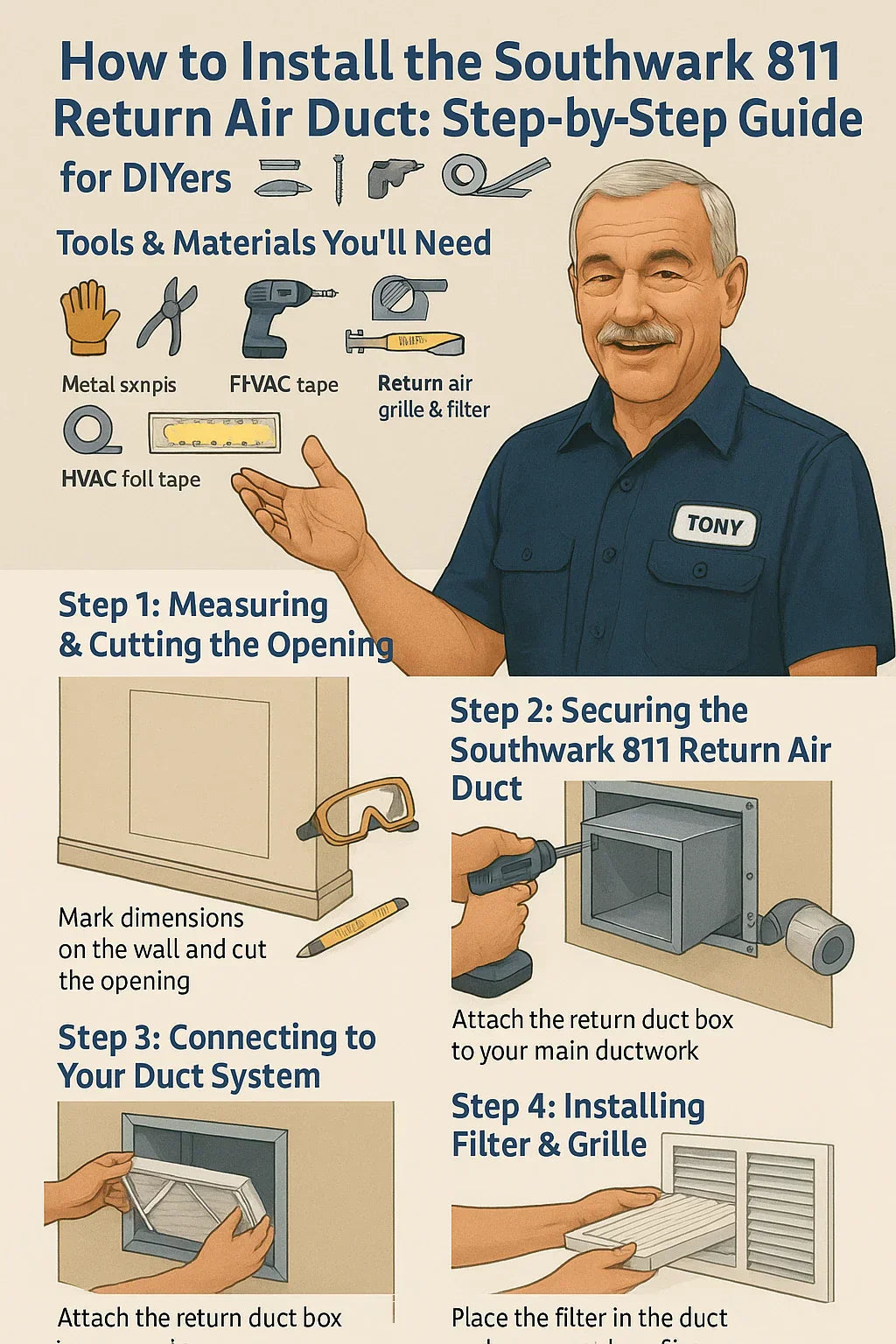🔧 Why Return Air Duct Installation Matters
👋 “Hey folks, Tony here. Let me start by saying this: your HVAC system is only as strong as its airflow. That means your return air duct—the part that pulls used air back into your system—is just as important as your supply ducts. Install it wrong, and your system will struggle, your energy bills will climb, and your comfort will tank. Install it right, and you’ll be breathing easy for years to come.”
Why it matters:
-
Balanced airflow prevents pressure issues
-
Proper ducting improves energy efficiency
-
Keeps your air filter accessible
-
Enhances indoor air quality (IAQ)
📎 HVAC.com explains the role of return vents in airflow balance.
🏠 Choosing the Right Spot for Your Southwark 811
Before you grab the saw, location is everything.
Best Locations:
-
Hallways (centralized returns work well here)
-
Living rooms / common areas for larger returns
-
Bedrooms (if using multiple returns for even comfort)
Spots to Avoid:
-
Kitchens (cooking odors & grease)
-
Bathrooms (moisture & smells)
-
Behind large furniture or curtains (restricted airflow)
📎 Trane highlights why return duct placement impacts comfort.
📐 Tools & Materials Checklist
-
Southwark 811 Return Air Duct (20x10–25x16 sizes)
-
Metal snips or jigsaw
-
Drill & driver set
-
Sheet metal screws
-
HVAC foil tape or mastic sealant
-
Measuring tape & level
-
Utility knife
-
Stud finder
-
Screwdriver set
-
Return grille + air filter
Tony’s Tip: “Don’t cheap out on foil tape—duct tape won’t cut it. HVAC-rated foil tape or mastic is the only way to go.”
📎 Energy.gov confirms duct sealing can save 20–30% in energy.
✂️ Step 1: Measuring & Cutting the Opening
-
Locate studs & obstacles with a stud finder.
-
Mark your dimensions (20x10–25x16 depending on your Southwark duct).
-
Score drywall with a utility knife.
-
Cut opening using a jigsaw or drywall saw.
⚠️ Safety Note: Wear gloves, goggles, and a mask—dust and sharp edges are no joke.
Tony’s Pro Reminder: “Measure twice, cut once. You’d be surprised how many times I’ve had to fix holes cut too big for the grille.”
🔩 Step 2: Securing the Southwark 811 Return Air Duct
-
Slide the duct box into the wall cavity.
-
Align flush with the drywall.
-
Fasten with sheet metal screws into framing.
-
Seal edges with foil tape or mastic.
➡️ This prevents air leaks, which waste money and reduce performance.
🧰 Step 3: Connecting to Your Duct System
Now the duct box must tie into your main return trunk line.
Options:
-
Rigid sheet metal ducting (best efficiency & durability)
-
Flex ducting (easier install, slightly less efficient)
Steps:
-
Attach collar or takeoff fitting to the Southwark 811.
-
Connect duct run to main trunk line.
-
Use screws + foil tape/mastic at every joint.
📎 Hartman Brothers explain that undersized or leaky returns kill efficiency.
🧼 Step 4: Installing the Filter & Grille
-
Insert the proper-sized filter into the return duct opening.
-
Attach the grille cover with screws.
-
Ensure grille is snug—no rattles or gaps.
Tony’s Tip: “Always install the filter slot so it’s easy to change—if it’s a pain, you’ll put it off, and your system will suffer.”
📎 Wamboldt HVAC notes that filters in the return protect the system from dirt and debris.
🔍 Step 5: Testing for Proper Airflow
-
Fire up your HVAC system.
-
Place your hand at the grille.
-
You should feel steady suction (air pulling inward).
-
Listen for whistling (restriction) or rattling (loose grille).
If airflow feels weak → check for blockages or undersized duct runs.
📎 BHG explains return vent direction and how it impacts efficiency.
🚫 Common DIY Mistakes to Avoid
-
❌ Cutting too small an opening
-
❌ Forgetting to seal seams (major energy waste)
-
❌ Blocking returns with furniture/rugs
-
❌ Using the wrong size filter
-
❌ Forgetting airflow balance (supply vs. return mismatch)
📎 Southern Living warns that closing or blocking vents hurts HVAC performance.
🛠️ Tony’s Advanced Tips (Pro-Level Install)
-
Use a bell-mouth fitting inside the duct to smooth airflow and reduce noise.
-
Add insulation around return ductwork to prevent heat gain/loss.
-
For larger systems, consider multiple returns to keep airflow balanced.
-
Always check system tonnage vs. duct size (CFM rule: ~400 CFM per ton).
❓ FAQs About Return Air Duct Installation
Q: Can I install a Southwark 811 duct myself?
A: Yes—if you’re comfortable cutting drywall, handling sheet metal, and sealing ducts. Otherwise, leave trunk line connections to a pro.
Q: How do I know if my duct is big enough?
A: Match the duct opening to your HVAC system’s CFM needs. Example: 25x16 handles ~800 CFM (~2 tons).
Q: Do I need more than one return?
A: Larger systems (3+ tons) almost always benefit from multiple returns for balanced airflow.
✅ Final Word from Tony
👨🔧 “Installing the Southwark 811 return air duct isn’t the hardest DIY job, but it does take patience and precision. Do it right, and you’ll boost comfort, save money, and extend the life of your HVAC system. Do it wrong, and you’ll be calling me out with a saw and a bill. So take your time, seal every joint, and give your system the breathing room it deserves.”
In the next topic we will know more about: Return Air Duct Materials Compared: Why Sheet Metal Still Wins







